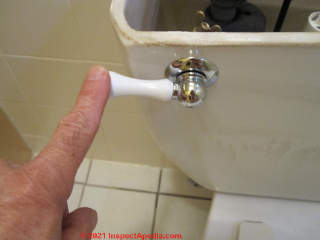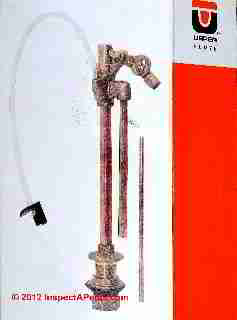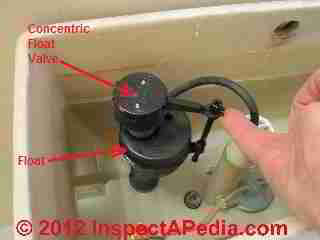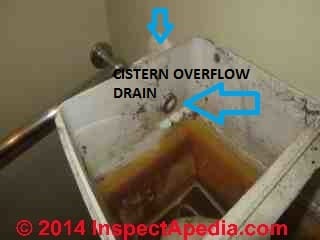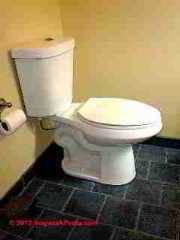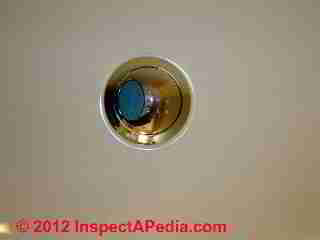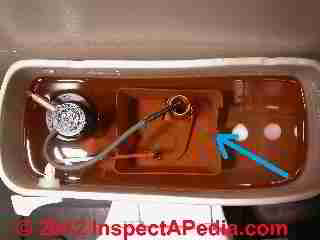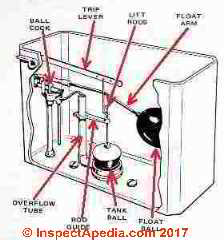 Toilet Flush Mechanisms
Toilet Flush Mechanisms
How Flush Toilets Work, parts & features
- POST a QUESTION or COMMENT about toilet cisterns or toilet tank flush reservoirs
Toilet cisterns & flush tanks:
This article explains how a flush toilet operates and describes the types, parts, and operation of the toilet cistern or toilet flush tank.
This article series describes the different types and models of toilets: historical or old toilet types, wooden high wall-tank toilets, conventional reservoir tank toilets, low-flush toilets, water saving toilets, back-flush toilets, up-flush toilets, and even chemical toilets. Here we explain how to diagnose and repair problems with toilets, leaks, flushes, odors, noises, running and wasted water.
InspectAPedia tolerates no conflicts of interest. We have no relationship with advertisers, products, or services discussed at this website.
Toilet Tank-Reservoir (Cistern) Flush Toilets & How They Work
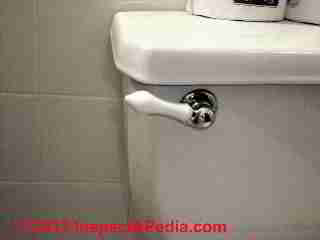
Tank reservoir toilets have been in wide use since the 1940's and some tank reservoir or cistern flushed toilets have been in use for more than 100 years. At left we see the flush handle on a modern tank or cistern operated gravity flush toilet.
[Click to enlarge any image]
While there have been improvements in toilet tank fill valves, flush valves, floats, and water savings, the design has remained about the same.
Here we describe the basic sequence of operation when a toilet is flushed and we explain the function of the key toilet flush and fill valves and diverter / overflow tubes.
Article Contents
- TOILET FLUSH OPERATION
- TOILET FLUSH HANDLE & LEVER
- TOILET FLUSH VALVE
- TOILET FILL VALVE
- TOILET DIVERTER & OVERFLOW TUBE
- OTHER TOILET FLUSH TYPES - listed below
- BACK FLUSH TOILETS
- UP FLUSH TOILETS
- TOP FUSH TOILETS
- LOW WATER USAGE TOILETS
- FLUSHMATE POWER FLUSH TOILETS
- ELECTRIC FLUSH TOILETS
- FLUSHOMETER TOILETS that do not use a cistern or tank
- CONTEMPORARY TOILET DESIGNS - separate article offers more toilet shapes and a catalog of types of modern flush toilets
What Happens when a Toilet is Flushed: 3 Basic Operations
- Flushing the toilet opens the flush valve: Pushing down on the toilet flush handle or lever (or on some toilets lifting or pressing a button) operates
the TOILET FLUSH LEVER
that in turn moves the flush lever arm inside the toilet tank or cistern in order to lift a flapper valve or tank ball to permit water to rush into the toilet bowl below, washing away waste into the sewer pipe. [Other toilets may use a siphon-flush valve to activate the flush cycle.]
Details are at TOILET FLUSH VALVE
At the end of the flush cycle, a float arm, or a float moving on a vertical stalk (newer valves) drops to open a valve permitting the toilet tank to refill with water. - Re-Filling the Toilet Cistern or Tank: When the toilet tank water level reaches the proper level, the float closes the toilet tank fill valve.
Details are at TOILET FILL VALVE - Additional Water Enters the Toilet Bowl: during the re-filling of the cistern or toilet tank, as long as the toilet fill valve is open to allow water to enter the toilet, most designs use a small diameter tube to direct a portion of the incoming water down the cistern tank overflow tube (see sketch above) and into the toilet bowl.
This extra water helps assure a proper level of water in the toilet bowl to prepare it for its next use.
Details are at TOILET DIVERTER & OVERFLOW TUBE
Following our description (below) of how the flush valve works and how the fill-valve re-fills the toilet tank or cistern we describe the operation of a variety of other toilet types including:
Toilet Flush Handle & Flush Lever
The toilet flush handle shown here, when pushed down, lifts the flush lever inside the tank in order to lift or open the flush valve (flapper valve) to flush the toilet.
Below you can see, in our first photo, the end of the flush lever that, lifted by the flush handle, pulls a chain that lifts and opens the flush valve.
If you need to replace the toilet flush handle and/or flush lever (they come together as an assembly) see details
at TOILET FLUSH HANDLE LEVER REPLACEMENT
Toilet Flush Valves
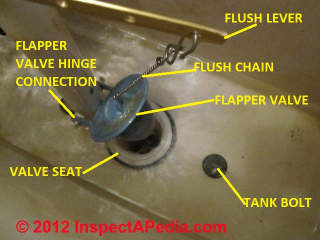 What happens inside the toilet cistern / tank when the toilet is flushed?
What happens inside the toilet cistern / tank when the toilet is flushed?
When a gravity type toilet is flushed, the toilet flush valve sends water out of the toilet tank or cistern (conventional flush valves) or directly from the building water supply without a toilet tank or cistern (flushometer valves) into the toilet bowl below to flush waste into the building drain system.
The two most common toilet flush valves used on toilets that make use of a tank or cistern are the flapper type toilet flush valve (illustrated just below) and the tank ball type toilet flush valve (illustrated further below).
Flapper type toilet flush valve: (photo at left) (see below) is a toilet flush valve that closes the opening at the bottom of the toilet tank using a semi-round flapper (usually rubber) rather than the rounded tank ball shown in the sketch.
Like the toilet tank ball type flush valve (illustrated in the sketch below), the flapper valve is pulled up to open the toilet reservoir tank drain opening to send flush water down into the toilet.
The shape and position of the flapper cause it to remain in the open position until the water level in the toilet tank drops to nearly empty, then the flapper "flaps" down over the drain opening to stop the toilet flush cycle and to permit the toilet fill cycle to begin anew.
 On modern tank type toilets we see mostly flapper valves; tank ball flush valves (below) are still found on older equipment however.
On modern tank type toilets we see mostly flapper valves; tank ball flush valves (below) are still found on older equipment however.
Once the flapper valve is closed, water pressure from the filling toilet tank or cistern presses the valve face against the valve seat, holding it shut against leakage.
Toilet flush valve repair: If your toilet is "running" and has a flapper valve, often the leak between cistern and bowl is at this valve. Try cleaning the valve seat. If that doesn't work, a new flapper valve may cure the leak.
Other repairs include an epoxy add-on new flush valve seat that glues atop the existing one, or else disassembly of the toilet tank to replace the entire assembly.
If your toilet uses a tank ball flush valve, be sure that the lift rods move freely and are not bent or binding. The opening in the rod guide (see sketch at left) that guides the lift rod should be centered over the center of the tank ball.
Tank ball type flush valve: the control that sends water from the toilet tank (or building water supply) into the toilet bowl to flush away waste.
There are many models of flush valves, using varying designs.
A tank ball flush valve assembly is shown in the sketch at above left.
In a traditional side float flush valve assembly (sketch at left) the toilet is flushed by pressing on a handle outside the toilet tank that lifts a trip lever that pulls a chain or rod that lifts a tank ball or a tank flapper that otherwise seals the bottom of the toilet tank.
For modern toilets important are designs that conserve water either through the valve design itself (see Top Flush Control Toilets) or by means of a plastic "dam" around the valve assembly.
Toilet Flush Valve or Flush Control Operating Details
 The toilet flush valve sends water out of the toilet tank or cistern (conventional flush valves) or directly from the building water supply without a toilet tank or cistern (flushometer valves) into the toilet bowl below to flush waste into the building drain system.
The toilet flush valve sends water out of the toilet tank or cistern (conventional flush valves) or directly from the building water supply without a toilet tank or cistern (flushometer valves) into the toilet bowl below to flush waste into the building drain system.
The two most common toilet flush valves used on toilets that make use of a tank or cistern are the flapper type toilet flush valve (illustrated just below) and the tank ball type toilet flush valve (illustrated further below).
Flapper type toilet flush valve: (photo at left) (see below) is a toilet flush valve that closes the opening at the bottom of the toilet tank using a semi-round flapper (usually rubber) rather than the rounded tank ball shown in the sketch.
Like the toilet tank ball type flush valve (illustrated in the sketch below), the flapper valve is pulled up to open the toilet reservoir tank drain opening to send flush water down into the toilet.
The shape and position of the flapper cause it to remain in the open position until the water level in the toilet tank drops to nearly empty, then the flapper "flaps" down over the drain opening to stop the toilet flush cycle and to permit the toilet fill cycle to begin anew.
On modern tank type toilets we see mostly flapper valves; tank ball flush valves (below) are still found on older equipment however.
Once the flapper valve is closed, water pressure from the filling toilet tank or cistern presses the valve face against the valve seat, holding it shut against leakage.
If your toilet is "running" and has a flapper valve, often the leak between cistern and bowl is at this valve. Try cleaning the valve seat. If that doesn't work, a new flapper valve may cure the leak.
Other repairs include an epoxy add-on new flush valve seat that glues atop the existing one, or else disassembly of the toilet tank to replace the entire assembly.
If your toilet uses a tank ball flush valve, be sure that the lift rods move freely and are not bent or binding. The opening in the rod guide (see sketch at left) that guides the lift rod should be centered over the center of the tank ball.
Tank ball type flush valve: the control that sends water from the toilet tank (or building water supply) into the toilet bowl to flush away waste. There are many models of flush valves, using varying designs.
A tank ball flush valve assembly is shown in the sketch at above left.
In a traditional side float flush valve assembly (sketch at left) the toilet is flushed by pressing on a handle outside the toilet tank that lifts a trip lever that pulls a chain or rod that lifts a tank ball or a tank flapper that otherwise seals the bottom of the toilet tank.
For modern toilets important are designs that conserve water either through the valve design itself (see Top Flush Control Toilets) or by means of a plastic "dam" around the valve assembly.
Flushometer or flush-o-meter toilet valves & toilets: these tankless toilets are flushed using building water pressure and a vacuum-breaker valve control.
See FLUSHOMETER VALVES for TOILETS URINALS for details about these valves and how they are adjusted or repaired.
Also see TOILET TYPES, FLUSH METHODS for a discussion of variations in toilet flush mechanisms & methods.
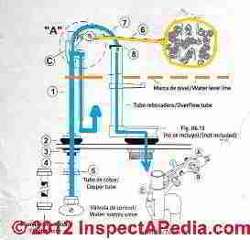 Gravity flush toilet: (sketch at left) the conventional and most common water-operated toilet world-wide is flushed by water that flows (from a reservoir tank) into the toilet bowl by gravity; the reservoir tank must be above and is typically attached to or part of the toilet assembly, though early flush toilets (illustrated below) placed the flush tank much higher on the wall in an effort to obtain a more cleansing flush for early bowl designs.
Gravity flush toilet: (sketch at left) the conventional and most common water-operated toilet world-wide is flushed by water that flows (from a reservoir tank) into the toilet bowl by gravity; the reservoir tank must be above and is typically attached to or part of the toilet assembly, though early flush toilets (illustrated below) placed the flush tank much higher on the wall in an effort to obtain a more cleansing flush for early bowl designs.
When the toilet is "flushed" using its handle, a flush control valve (see "tank ball in our sketch above) opens to send water from the reservoir into the toilet bowl to flush it clean.
At the end of the toilet flush, a ball cock valve or equivalent (#1 & assembly "C" in our sketch at above-left) refills the toilet tank from the building cold water supply (the fat blue arrow in our sketch).
Hatbox toilet: a tankless toilet design by Kohler (illustrated below) that uses an electric pump to deliver flush water and adequate water velocity
Overflow tube, toilet: the overflow tube (item #8 in our sketch at left), is found on virtually all modern toilet flush control valve assemblies.
This tube prevents a malfunctioning toilet tank refill assembly from flooding the building. (Unfortunately if the toilet drain is clogged and the toilet overflows you'll have a different sort of flood.
During toilet tank re-fill, if the tank over-fills, the overflow tube (blue #7 in sketch at left) will excess water from the toilet reservoir tank down the overflow tube (#8) into the toilet bowl.
This is a critical function since otherwise if the toilet fill-valve malfunctions water entering the toilet tank will fill the tank to overflowing and leak into the building. But if your toilet is "running" the problem may be just that - the fill valve is sending water continuously into the tank where it enters the overflow tube.
A second feature of most toilet fill valve assemblies and overflow tubes is that some water will be diverted from the fill valve into the overflow tube during the toilet tank fill-cycle - see the small curved blue tube marked #7 in our sketch above). This makes sure there is enough water in the toilet bowl before its next use.
Pressure-assist flush toilet: the toilet is flushed by water that is given a velocity boost by a pressure system using a pump,compressed, air, or other means. Typically pressure-assist toilet designs are found on water-saving low-flush-volume toilets.
Flushometer or flush-o-meter toilet valves & toilets: these tankless toilets are flushed using building water pressure and a vacuum-breaker valve control.
See FLUSHOMETER VALVES for TOILETS URINALS for details about these valves and how they are adjusted or repaired.
Also see TOILET TYPES, FLUSH METHODS for a discussion of variations in toilet flush mechanisms & methods.
Toilet Fill Valves
Ball cock valve / Concentric Float Valve
The toilet ball cock fill valve shown in our photo at above left is a traditional side-float brass ball cock valve by Urrer is the control that refills the toilet tank after a flush. the rod that carries the float, the float itself and other toilet parts are not shown in this illustration.
Concentric float toilet fill valves (photo at above right) omit the rod, side-arm, and float ball. Instead a float rises on a vertical shaft that also supports the fill control valve.
In our photo my finger is pressing up on the lever that stops the flow of water into the toilet tank. You can see that an adjustable rod on the float (below the valve) will push up this stop lever on its own as the water level in the tank rises.
In some small-tank toilets we found that installing a concentric float toilet fill valve solved a problem of frequent jamming of the older side-float valve assembly whose float or rod would rub against the overflow tube or the toilet tank sides, jamming and giving recurrent "running toilet" problems.
Toilet Fill Valve Operation
The toilet fill valve admits water into the toilet reservoir tank or cistern to refill the cistern following a toilet flush. Most fill valve designs also send some water through the overflow tube and into the toilet bowl during cistern re-fill.
Two common fill valve designs in current use are the ball-cock toilet fill valve and the concentric float toilet fill valve. Both of those designs are illustrated above.
Synonyms for toilet fill valves include: ball cock valve, concentric float valve, toilet water supply valve, toilet tank fill valve.
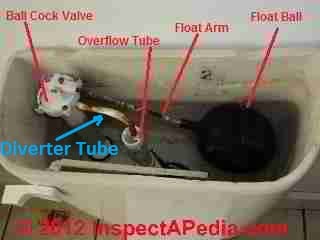
Toilet Cistern / Tank Float-Controlled Fill Valve
The toilet tank float assembly activates the toilet fill valve as water level in the toilet tank or cistern drops during and at the end of a toilet flush.
Illustrated above at concentric float toilet fill valves, the float for that device is a cylinder that moves down or up on a vertical shaft as tank (cistern) water level in the cistern falls or rises, to open or close the fill valve itself.
A ball cock toilet fill valve is opened by movement of a float arm rod attached to a round float ball (illustrated at left) that drops as water level in the cistern falls during a flush, and the ball cock valve is closed as the float rises, lifting the rod to which it is attached as the water level in the toilet tank rises to the fill line.
In our photo (above left) a white plastic ball cock fill valve is shown in lieu of the older traditional brass and bronze ball cock valve illustrated earlier on this page.
Toilet tank float adjustment procedure
Adjust the float lever angle so that combined with the ball cock shutoff adjustment the assembly stops water flow into the water tank when water reaches the fill line marked on the tank.
If you do not see a fill line marked in the toilet cistern, set the fill level at least 1/4" below the top of the overflow tube.
Also be sure that the float ball moves freely in the toilet tank. If the float ball rubs on the tank sides or end it is likely to jam and the toilet may not fill properly, or the toilet may run continuously.
Toilet Overflow Tube & Diverter Tube
Toilet Diverter Tube & Overflow Tube Bowl-Fill Operation
[Click to enlarge any image]
Overflow tube, toilet: the overflow tube (photo above left), is found on virtually all modern toilet flush control valve assemblies.
This tube prevents a malfunctioning toilet tank refill assembly from flooding the building.
Unfortunately if the toilet drain is clogged and the toilet overflows you'll have a different sort of flood
See TOILET OVERFLOW EMERGENCY.
External toilet overflow tubes: On some toilets such as the toilet found in the Brew Moon restaurant in New Zealand, a separate overflow drain is provided and is connected to a waste line (blue arrows in our photo at above right).
This toilet cistern overflow drain has the sole function of preventing the toilet cistern from over-filling and spilling into the building.
During toilet tank re-fill, if the tank over-fills, the overflow tube (blue #7 in sketch at left) will excess water from the toilet reservoir tank down the overflow tube (#8) into the toilet bowl. This is a critical function since otherwise if the toilet fill-valve malfunctions water entering the toilet tank will fill the tank to overflowing and leak into the building.
But if your toilet is "running" the problem may be just that - the fill valve is sending water continuously into the tank where it enters the overflow tube.
Diverter tube empties into Overflow Tube: A second feature of most toilet fill valve assemblies and overflow tubes is that some water will be diverted from the fill valve into the overflow tube during the toilet tank fill-cycle (Thin blue arrow in the photo at above left). This makes sure there is enough water in the toilet bowl before its next use.
Other Toilet Flush Methods & Types
Here are descriptions of additional toilet designs that use different flush methods from those described above.
Back Flush or Rear Flush Toilets Using a Reservoir Tank
A back-flush toilet that does use a reservoir tank is also produced for special situations such as a location that prohibits installing a drain line in the floor below the toilet.
At below left we illustrate a back-flush toilet installed in a Two Harbors Minnesota home built in the 1960's.
Our second back-flush toilet photo (below right) shows a reservoir-tank back-flush toilet located in a basement in the Hudson Valley of New York. In this basement the sewer line ran just a few inches above the basement floor.
The plumber mounted a back-flush toilet on a short concrete pedestal, raising it just enough to flush into the nearby sewer line found in the wall behind the toilet.
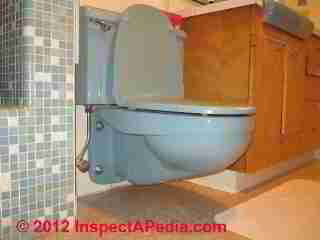
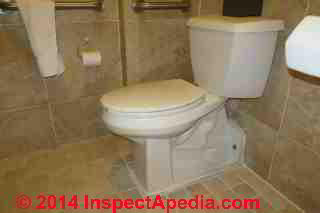
At above left is a photo of a modern tankless, back-flush, flush valve operated toilet installed in Molde, Norway.
This toilet is also a back-flush model, sending waste out of the bowl towards the rear of the toilet and into a waste line in the building wall rather than in the floor.
The flush control for this tankless (cisternless) back-flush toilet is that round button just above the toilet tissue holder. Other water operated tankless toilets that are not back-flush models are discussed
at FLUSHOMETER TOILETS & URINALS.
At above right is a rear-flush toilet manufactured by Crane and installed in the Mansfield Hotel in New York City. Other modern brands of rear-flush toilets include American Standard, Burdett, Crane, Gerber, Kohler, Sani-Flow, Toto.
Up-Flush Toilets Located Below the Sewer Piping, No Toilet Tank
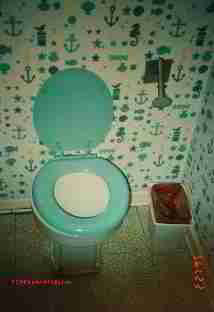 A variation on the flush valve toilet is the up-flush toilet used in bathrooms whose toilet was located below the building's sewer line exit to the sewer or septic system.
A variation on the flush valve toilet is the up-flush toilet used in bathrooms whose toilet was located below the building's sewer line exit to the sewer or septic system.
An up-flush toilet relies on building water pressure to force the waste from the toilet up to a higher sewer line.
Because an up-flush toilet that relies on building water pressure to work forms a cross connection, these toilets are not permitted by plumbing codes in most jurisdictions.
In our photo of an up-flush toilet you can see the flush control lever mounted on the wall at the upper right.
Like the modern flush-valve toilet shown above, the up-flush toilet is also a back flush or rear-flush model. But don't confuse the two.
The flush valve toilet shown above does not form a cross-connection, drains into a gravity-sewer line rather than an elevated sewer line, and it is permitted by current plumbing codes.
Top Flush Dual-Flush Control Toilets
Details about water conserving or water saving toilets begin
and at DUAL FLUSH TOILETS.
Separately at LOW WATER USAGE / POWER FLUSH TOILETS we discuss toilet that use a reduced water quantity, and
at FLUSHMATE TOILETS we discuss power-assisted flush toilets that also conserve water. Excerpts are just below.
Water saving models (typically a pair of buttons giving different flush volumes) illustrated below.
Dual-flush water saving toilets typically deliver 1.1 gallons to flush liquid waste or 1.6 gallons to flush solids.
Low Water Consumption Toilets - Water Saving Toilets
Details are at
LOW WATER USAGE / POWER FLUSH TOILETS where we discuss toilet that use a reduced water quantity, and at
FLUSHMATE TOILETS we discuss power-assisted flush toilets that also conserve water. Excerpts are just below.
Also see water conserving or water saving toilets that use different flush volumes for urine than for solid waste, now discussed at
TOP FLUSH TOILETS and at
DUAL FLUSH TOILETS.
Water saving toilets use several strategies to reduce the volume of water used in flushing away waste: varying flush volume, pressure or power assisted flush using a small flush water volume, and reduced flush water volume using a reservoir barrier in th cistern or toilet tank.
At LOW WATER USAGE / POWER FLUSH TOILETS we give the various water volumes used by each toilet type and design.
Air & Water Powered Flush Toilets (Pressure Assist): the Sloan Flushmate
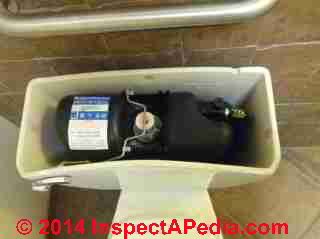 Details for power assist or power flush toilets like Sloan's Flushmate are found
Details for power assist or power flush toilets like Sloan's Flushmate are found
Power flush toilet model shown in our photo:
Sloan Flushmate® Model M-101526-F3 using a 1.6 gpf or 6LPF toilet flush volume. Other Flushmate® toilet models (Flushmate IV) use less than 1 gallon per flush.
The FLUSHMATE® system traps air and as it fills with water, it uses the water supply line pressure to compress the trapped air inside.
The compressed air is what forces the water into the bowl, so instead of the “pulling” or siphon action of a gravity unit, the pressure-assist unit “pushes” waste out.
This vigorous flushing action cleans the bowl better than gravity units. - quoted from www.flushmate.com, retrieved 2/2/2014
Electric Flush Toilets & Pressure Assisted-Flush Toilets
Our toilet photographs below illustrate a tankless, electric-flush toilet produced by Kohler. As you can see (below-left) the toilet may be a little unfamiliar to new visitors at the New Hampshire inn where this unit was installed.
Pressure-assisted flush toilets may use water pressure from the water mains to improve the flush cleansing of the bowl, or they may use a pump or an air bladder system that is in turn operated by water pressure.
By providing a more aggressive and higher velocity flush than a gravity flush toilet a pressure-assist system generally uses less water, ranging from 1.1 to 1.4 gallons.
Kohler Purist Hatbox Toilets
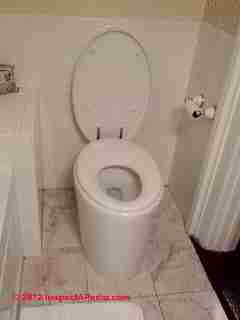
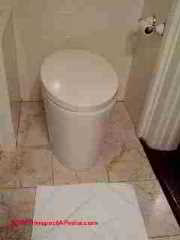
For a newcomer, flushing this Kohler hatbox toilet could be a bit of a mystery. Searching for a flush lever or button finally leads to a round silver button located on the right side (if the user is seated) of the unit (photo, below right).
Pushing the flush button on the older unit that we tested produced an aggressive and roaring "flush" along with a bit of pump noise.
Other literature describes these toilets as "quiet". Our photo at below left gives a clue about how this toilet was powered.
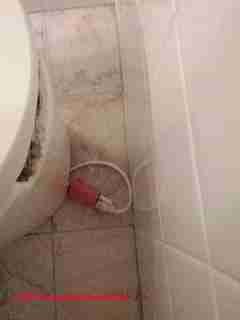
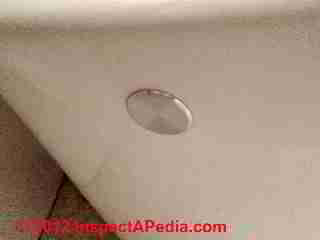
Newer versions of the electric flush toilet made by Kohler include a reservoir tank and an electric pump that moves water from the reservoir through the bowl and toilet trap.
This design offers a toilet that provides a low profile but nonetheless a very powerful flush in a compact design.
The Kohler hatbox toilet installation we examined had been in place for some time; this product is still available at a typical retail price of $2,725.
Flushometer Toilets & Urinals
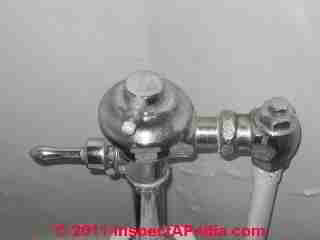 Tankless flush-o-meter valve toilets, in widespread use in North America since the 1920's, and unlike tank reservoir toilets, do not include a reservoir tank of water.
Tankless flush-o-meter valve toilets, in widespread use in North America since the 1920's, and unlike tank reservoir toilets, do not include a reservoir tank of water.
The flushometer valve is particularly suitable to public restrooms since there is no delay between toilet uses waiting for a reservoir tank to refill. Typical flush volume is 1.6 gallons.
Details are
at FLUSHOMETER TOILETS & URINALS
...
Continue reading at TOILET FLUSH VOLUME or select a topic from the closely-related articles below, or see the complete ARTICLE INDEX.
Or see TOILET FLUSH OPERATION FAQs - question & answers about flush toilet parts and repairs posted originally on this page.
Or see
- CLOGGED DRAIN DIAGNOSIS
- TOILET FLUSHES POORLY
- TOILETS, INSPECT, INSTALL, REPAIR - home - this toilet buy, install or repair guide article series discusses the cause, diagnosis, and repair of toilet problems (water closet problems) such as a toilet that does not flush well, clogged toilets, slow-filling toilets, running toilets, loose wobbly toilets, and odors at leaky toilets.
- TOILET RUNS CONTINUOUSLY
Suggested citation for this web page
TOILET FLUSH OPERATION at InspectApedia.com - online encyclopedia of building & environmental inspection, testing, diagnosis, repair, & problem prevention advice.
Or see this
INDEX to RELATED ARTICLES: ARTICLE INDEX to TOILET INFORMATION
Or use the SEARCH BOX found below to Ask a Question or Search InspectApedia
Ask a Question or Search InspectApedia
Try the search box just below, or if you prefer, post a question or comment in the Comments box below and we will respond promptly.
Search the InspectApedia website
Note: appearance of your Comment below may be delayed: if your comment contains an image, photograph, web link, or text that looks to the software as if it might be a web link, your posting will appear after it has been approved by a moderator. Apologies for the delay.
Only one image can be added per comment but you can post as many comments, and therefore images, as you like.
You will not receive a notification when a response to your question has been posted.
Please bookmark this page to make it easy for you to check back for our response.
Our Comment Box is provided by Countable Web Productions countable.ca
Citations & References
In addition to any citations in the article above, a full list is available on request.
- "Story: Rock, limestone and clay Part of page 8 – Ceramics and pottery ", TEARA, The Encyclopedia of New Zealand, Video retrieved 9/18/14, original source: http://www.teara.govt.nz/en/video/5254/clay-toilets, Te Ara, Manatū Taonga Ministry for Culture and Heritage, PO Box 5364, Wellington, New Zealand, Tel: +64 4 499 4229, Email: TeAra@mch.govt.nz
- [1] Carson Dunlop provides home inspection education including the ASHI-adopted a Home Inspection Home Study Course, and publications such as the Home Reference Book, the Home Reference eBook, and report writing materials including the Horizon report writer, and home inspect ion services. Alan Carson is a past president of ASHI, the American Society of Home Inspectors.
- [2] 1991 ADA Standards for Accessible Design, U.S. Department of Justice, 28 CFR Part 36, Revised as of July 1, 1994, excerpts; web search 5/10/12, original source: http://www.ada.gov/stdspdf.htm [copy on file as ADA_Standards_1994.pdf]
- [3] Alliance for Water Efficiency, 300 W Adams Street, Suite 601
Chicago, Illinois 60606, Tel: 866-730-A4WE, Website: http://www.allianceforwaterefficiency.org/ Quoting:
The Alliance for Water Efficiency is a stakeholder-based 501(c)(3) non-profit organization dedicated to the efficient and sustainable use of water. Located in Chicago, the Alliance serves as a North American advocate for water efficient products and programs, and provides information and assistance on water conservation efforts. - OSHA toilet standards: OSHA's sanitation standard for general industry, 29 CFR 1910.141(c)(l)(i), specifies that employers shall provide toilet facilities for their employees. Web-search 5/10/12, original source:
http://www.osha.gov/pls/oshaweb/owadisp.show_document?p_id
=22932&p_table=INTERPRETATIONS - [4] Toilet Manufacturers' Product literature or websites were consulted for the following:
- American Standard brand toilets (illustrated in this article), includes these additional plumbing fixture & component brands: Jade, Porcher (see below), Crane Plumbing, Eljer, Fiat, American StandardsProSite, Safety Tubs, http://www.americanstandard-us.com/
- Atlas International brand toilets, Atlas USA, http://atlasusa.net/
- Barclay brand toilets, Barclay Products Limited, 4000 Porett Dr., Gurnee, IL 60031, 847-244-1234, website: http://www.barclayproducts.com/
- Caroma brand toilets, Caroma is Australian company; in Canada & the USA Tel: 800-605-4218, website: http://www.caromausa.com/
- Church Seats, [toilet seats only], http://www.churchseats.com/ - our photo (left) shows a church toilet seat installed.
- Circle City Copperworks 9325 Uptown Dr., Suite 500 Indianapolis, IN 46256-1079, sinks, other copper products, not toilets, website: http://www.circlecitycopperworks.com/
- Crane Plumbing - see American Standard Products, above
- Danze brand toilets, Tel: USA: 1-877-530-3344, Canada: 1-866-884-8841 http://www.danze.com/room_solutions.asp
- Eljer brand toilets, (e.g. Titan one-piece elongated bowl 16 1/8" ADA-compliant)
- Gerber brand toilets (e.g. Gerber Ultra Dual Flush elongated ErgoHeight DF-21-318 pressure-assisted 1.6 gallon flush unit.), USA: 1-866-538-5536 (9AM-6PM) Mon-Fri Canada: 1-866-884-8841 (8:30AM-5PM) Mon-Fri, http://www.gerberonline.com/default.aspx
- Glacier Bay brand toilets, [Home Depot brand] porcelain, made in china, top flush control low-water ADA-height unit shown in this article. Cf. Globe Union Industrial Company of Canada, China, elsewhere. Also see Pegasus, Danze, Gerber. Glacier Bay Faucets and sanitaryware, 2455 Paces Ferry Road NW, .Atlanta, Ga. 30339-4024, 800-220-3036. http://www.glacierbayfaucetsreview.com/
- Hastings Tile & Bath toilets, includes "hatbox" and wall mount sinks, bidets, & toilets, 30 Commercial Street Freeport, N. Y. 11520, Tel: (516) 379-3500. http://www.hastingstilebath.com,
- Herbeau Creations brand toilets, Herbeau Creations of America 3600 Westview Drive Naples, FL 34104, Tel: (800) 547-1608, (since 1857), http://www.herbeau.com/Products.aspx?Item=5501
- Inax brand toilets, 15 West 20th Street, New York, NY 10011, Tel: 855-823-4434, http://www.inax-usa.com/gallery-ny/
- Jacuzzi brand toilets, Tel: 800-288-4002., website: http://www.jacuzzi.com/
- Jade, see American Standard Products, above
- Jemal Wright Bath Designs toilets, Brazil & USA, 3140 SW 19th St. #572, Hallandale FL 33009 USA, Tel: 305-915-0960, email: info@jemalwright.com, website: http://www.jemalwright.com/
- Kohler® brand toilets, Kohler Co. 444 Highland Drive Kohler, WI 53044, Tel 800-456-4537, Website http://www.kohler.com/corporate/index.html
- Laufen Ceramicware brand toilets, world wide, LAUFEN Bathrooms AG Wahlenstrasse 46 CH-4242 Laufen, USA: Laufen Bathrooms North America 11190 NW 25th Street Miami, FL 33172, Tel: Tel: +1 866.696.2493 / +1 305.357.6130, Website: http://www.laufen.com
- LeBijou brand toilets, - good luck finding this company or a home page for them - Ed.
- Mirabelle brand toilets (e.g. Key West MIRKW241ABS), showrooms in the U.S. & Canada, Email: info@mirabelleproducts.com, Website: http://www.mirabelleproducts.com/
- Nameek's brand toilets, 1561 Gehman Rd., Harleysville, PA 19438, Tel: (215) 256-4197, Website: http://www.nameeks.com/Bathroom/
- Neo-Metro Collection brand toilets, Neo-Metro 15125 Proctor Ave City of Industry CA 91746 U.S.A, Tel: 800.591.9050, Website: http://www.neo-metro.com
- Panasonic brand toilets, (e.g. Panasonic toilet bowl with warm water flush system for washing user beauty cabinet de toilette W moment-type pearl ivory DL-WD60-CP; also the Zaraku portable toilet - http://ex-blog.panasonic.co.jp/exhibition/en/2008/09/hcr08_400.html)
- Porcher brand toilets, originally a French brand, acquired by American Standard Companies in 1992, Website: http://www.porcher-us.com/
- ProFlo brand toilets (e.g. Proflo PFCT 103WH)
- Rapsel brand toilets,RAPSEL Spa Via Volta 13 - 20019 Settimo Milanese (MI), Italy Tel. 0039 02 3355981 Fax. 0039 02 33501306, Email: rapsel@rapsel.it Italian company, offices in Milan & New York, Website: http://www.rapsel.it/ or in the U.S. http://rapsel.wordpress.com/
- Samuel Heath brand toilets, US & UK, USA Customer Service 111 E. 39th St. 2R New York NY 10016, Tel: 212 599 5177, Email: usa@samuel-heath.com, or UK Head Office Samuel Heath & Sons plc Leopold Street Birmingham B12 0UJ, Tel: +44 121 766 4200, Email: info@samuel-heath.comWebsite: http://www.samuel-heath.com/
- Sterling brand toilets (e.g. Rockton S4020880), Sterling Plumbing 444 Highland Drive Kohler, WI 53044, Tel: 800-783-7546, Website: http://www.sterlingplumbing.com/
- St. Thomas Creations brand toilets, St. Thomas Creations 3A South Middlesex Avenue Monroe Township, New Jersey 08831 USA, Tel. (800) 536-BATH (800-536-2284) Fax (609) 655- 2421, Email: E-Mail: info@stthomascreations.com, Website: http://www.stthomascreations.com/
- Toto brand toilets (e.g. Toto Drake CST744S, Neorest Hybrid, ) Brazil & USA, TOTO USA, INC. 1155 Southern Road Morrow, Georgia 30260, Tel: 888-295-8134, Tel: 1-888-295-8134, Email: custservice@totousa.com techsupport@totousa.com, Website: http://www.totousa.com
- Villeroy & Boch Bath & Kitchen brand toilets, International, offices in Canada, Mexico, United States, Villeroy & Boch AG Corporate Headquarters P.O. Box 1120 D 66688 Mettlach, Phone +49 (0) 68 64 - 81 - 0, Website: http://www.villeroy-boch.com/, Company founded 1748.
- VitrA USA brand toilets, International, Brazil?, USA contact: Shawnee North Business Center 305 Shawnee North Drive Suite 600 Shawnee USA, Phone : +1 770 904 68 30 Fax : +1 770 904 68 91 www.vitra-usa.com, Website: http://usa.vitra.com.tr/
- Whitehaus Collection brand toilets, Whitehaus Collection - 589 Boston Post Rd. West Haven, CT 06516 USA, Tel: 800.527.6690, Email: info@whitehauscollection.com, Website: http://whitehauscollection.com
- [5] Wikipedia Web: https://www.wikipedia.org/ provided background information about some topics discussed at this website provided this citation is also found in the same article along with a " retrieved on" date. NOTE: because Wikipedia entries are fluid and can be amended in real time, we cite the retrieval date of Wikipedia citations and we do not assert that the information found there is necessarily authoritative.
- "Flush Toilet", web search 5/10/12, original source: http://en.wikipedia.org/wiki/Flush_toilet#Tank_style_with_flapper-flush-valve
- "Japanese bidet toilet", web search 5/13/12, original source: http://en.wikipedia.org/wiki/Japanese_toilets
McMahon, M.A.S., & Wilson, I.G. (2001). The occurrence of enteric pathogens and Aeromonas species in organic vegetables. International Journal of Food Microbiology, 70(1-2),155-162.
- US EPA ONSITE WASTEWATER TREATMENT SYSTEMS MANUAL [online copy, free] Top Reference: US EPA's Design Manual for Onsite Wastewater Treatment and Disposal, 1980, available from the US EPA, the US GPO Superintendent of Documents (Pueblo CO), and from the National Small Flows Clearinghouse. Original source http://www.epa.gov/ORD/NRMRL/Pubs/625R00008/625R00008.htm Onsite wastewater treatment and disposal systems, Richard J Otis, published by the US EPA. Although it's more than 20 years old, this book remains a useful reference for septic system designers. U.S. Environmental Protection Agency, Office of Water Program Operations; Office of Research and Development, Municipal Environmental Research Laboratory; (1980)
- Eco John® Innovative Toilet Solutions, Global Inventive Industries, Fountain Valley CA, PDF, product brochure
- "International Private Sewage Disposal Code," 1995, BOCA-708-799-2300, ICBO-310-699-0541, SBCCI 205-591-1853, available from those code associations.
- "Manual of Policy, Procedures, and Guidelines for Onsite Sewage Systems," Ontario Reg. 374/81, Part VII of the Environmental Protection Act (Canada), ISBN 0-7743-7303-2, Ministry of the Environment,135 St. Clair Ave. West, Toronto Ontario M4V 1P5 Canada $24. CDN.
- Manual of Septic Tank Practice, US Public Health Service's 1959.
- Onsite Wastewater Disposal, R. J. Perkins; Quoting from Amazon: This practical book, co-published with the National Environmental Health Association, describes the step-by-step procedures needed to avoid common pitfalls in septic system technology. Valuable in matching the septic system to the site-specific conditions, this useful book will help you install a reliable system in both suitable and difficult environments. Septic tank installers, planners, state and local regulators, civil and sanitary engineers, consulting engineers, architects, homeowners, academics, and land developers will find this publication valuable.
- Onsite Wastewater Treatment Systems, Bennette D. Burks, Mary Margaret Minnis, Hogarth House 1994 - one of the best septic system books around, suffering a bit from small fonts and a weak index. While it contains some material more technical than needed by homeowners, Burks/Minnis book on onsite wastewater treatment systems a very useful reference for both property owners and septic system designers.
- Septic System Owner's Manual, Lloyd Kahn, Blair Allen, Julie Jones, Shelter Publications, 2000 $14.95 U.S. - easy to understand, well illustrated, one of the best practical references around on septic design basics including some advanced systems; a little short on safety and maintenance. Both new and used (low priced copies are available, and we think the authors are working on an updated edition--DF. Quoting from one of several Amazon reviews: The basics of septic systems, from underground systems and failures to what the owner can do to promote and maintain a healthy system, is revealed in an excellent guide essential for any who reside on a septic system. Rural residents receive a primer on not only the basics; but how to conduct period inspections and what to do when things go wrong. History also figures into the fine coverage.
- US EPA ONSITE WASTEWATER TREATMENT SYSTEMS MANUAL Top Reference: US EPA's Design Manual for Onsite Wastewater Treatment and Disposal, 1980, available from the US EPA, the US GPO Superintendent of Documents (Pueblo CO), and from the National Small Flows Clearinghouse. Original source http://www.epa.gov/ORD/NRMRL/Pubs/625R00008/625R00008.htm
- Water Wells and Septic Systems Handbook, R. Dodge Woodson. This book is in the upper price range, but is worth the cost for serious septic installers and designers.
Quoting Amazon: Each year, thousands upon thousands of Americans install water wells and septic systems on their properties. But with a maze of codes governing their use along with a host of design requirements that ensure their functionality where can someone turn for comprehensive, one-stop guidance? Enter the Water Wells and Septic Systems Handbook from McGraw-Hill.
Written in language any property owner can understand yet detailed enough for professionals and technical students this easy-to-use volume delivers the latest techniques and code requirements for designing, building, rehabilitating, and maintaining private water wells and septic systems. Bolstered by a wealth of informative charts, tables, and illustrations, this book delivers:
* Current construction, maintenance, and repair methods
* New International Private Sewage Disposal Code
* Up-to-date standards from the American Water Works Association
- Wells and Septic System, Alth, Max and Charlet, Rev. by S. Blackwell Duncan, $ 18.95; Tab Books 1992. We have found this text very useful for conventional well and septic systems design and maintenance --DF. Quoting an Amazon description:Here's all the information you need to build a well or septic system yourself - and save a lot of time, money, and frustration. S. Blackwell Duncan has thoroughly revised and updated this second edition of Wells and Septic Systems to conform to current codes and requirements. He also has expanded this national bestseller to include new material on well and septic installation, water storage and distribution, water treatment, ecological considerations, and septic systems for problem building sites.
- The NSFC Products List has an excellent list of design manuals/modules National Small Flows Clearinghouse (NSFC) now (2019/12/13) hosted at http://www.nesc.wvu.edu/ Tel: 304-293-4191 e-mail info@mail.nesc.wvu.edu.
The National Small Flows Clearinghouse (NSFC) was funded by the U.S. Environmental Protection Agency (EPA) to help America's small communities and individuals solve their wastewater problems through objective information about onsite wastewater collection and treatment systems. NSFC products and information are the only national resource of its type, dealing with small community wastewater infrastructure. or by telephone 800-624-8301 - Our recommended books about building & mechanical systems design, inspection, problem diagnosis, and repair, and about indoor environment and IAQ testing, diagnosis, and cleanup are at the InspectAPedia Bookstore. Also see our Book Reviews - InspectAPedia.
- In addition to citations & references found in this article, see the research citations given at the end of the related articles found at our suggested
CONTINUE READING or RECOMMENDED ARTICLES.
- Carson, Dunlop & Associates Ltd., 120 Carlton Street Suite 407, Toronto ON M5A 4K2. Tel: (416) 964-9415 1-800-268-7070 Email: info@carsondunlop.com. Alan Carson is a past president of ASHI, the American Society of Home Inspectors.
Thanks to Alan Carson and Bob Dunlop, for permission for InspectAPedia to use text excerpts from The HOME REFERENCE BOOK - the Encyclopedia of Homes and to use illustrations from The ILLUSTRATED HOME .
Carson Dunlop Associates provides extensive home inspection education and report writing material. In gratitude we provide links to tsome Carson Dunlop Associates products and services.


